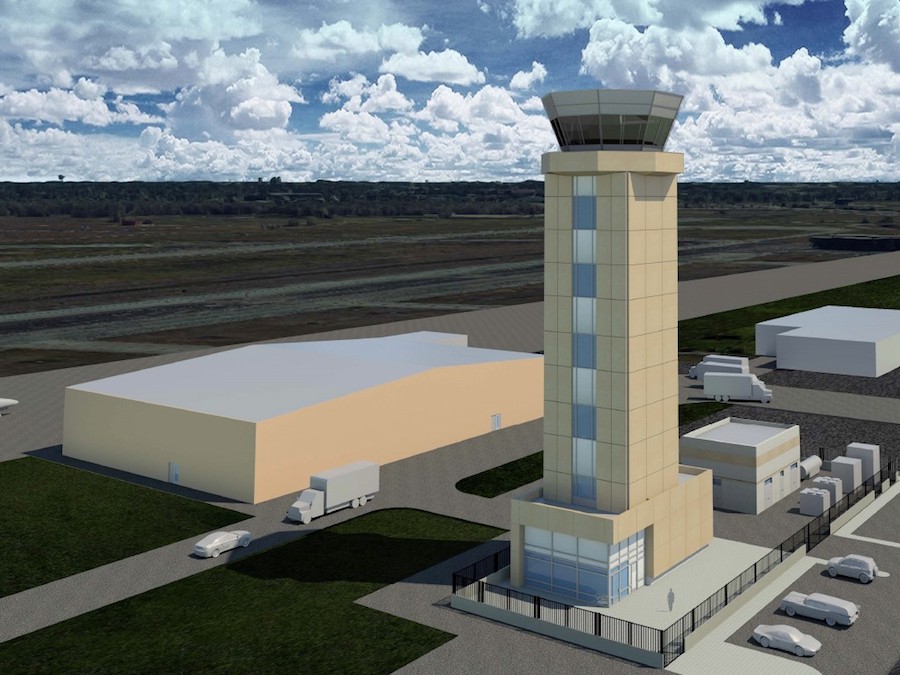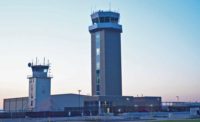Crews broke ground April 24 on Ellington Airport’s new $12.4 million air traffic control tower, which will replace the airport’s existing tower, originally built in 1955 and damaged in 2008 during Hurricane Ike. The new tower will both enhance current services and provide mission control support for future Houston Spaceport operations.
“The main driver for the project is to provide flexibility in the infrastructure development so as to be compatible for future users whether it be the city, National Guard, FAA, NASA or private spaceport entities,” explains Frank Wengler with AECOM. “Incorporation of FAA standards and best practices in a non-FAA air traffic control tower were the main challenges in the design, while balancing against goals to minimize project costs. Designing for multiple agencies provided a challenge for designers to provide separate, secured, areas for electronics equipment.”
Clark Construction Group is general contractor on the project and AECOM is architect of record.
“It’s a traditional design-bid-build method for delivering the tower, and that’s because it’s a federally reimbursable contract,” explains Devon Tiner, assistant director for design with the Houston Airport System. “We have a $3.1 million FAA AIP [Defense Economic Adjustment Assistance] grant that’s being used to help fund the project.” The remaining $9.3 million is coming from the Houston Airport System Airport Improvement Fund. Among the federal requirements is a DBE goal of 22%.
The project is also eligible for $2 million in grant funding through the FAA Airport Improvement Program, approval of which is pending.
Tiner notes that the only difference with this project compared to others at Ellington is the grant funding. “We actually are engaging in a lot of alternative delivery methods with our new Continental Terminal Redevelopment Program and some of the other projects that we’re doing, but they’re not grant funded,” he says.
The tower will reach 143 ft, which is almost twice as tall as the existing tower, and will utilize new features such as an automated weather observation system, which can determine cloud heights, temperature, rainfall amounts, the presence of lightning in the area and other conditions.
"Since this new tower will be constructed while the old tower is still in use, extra attention was necessary to ensure a smooth transition from the existing tower to the new tower. It was not necessarily a straight forward design," adds Aaron Boyce, construction admin manager at AECOM. "Since the new tower has a small footprint, an extended plenum was provided at two locations for telecom cabling."
Teams also designed the control tower to provide expansion space for future Spaceport operations, such as sizing the cab of the control tower to allow for a future control position dedicated to spaceport operations.
“If spaceport operations require additional building space, a second entrance into the control tower will accommodate access via a link from a separate spaceport administration building,” Wengler says. “This method of planning allows for a tower to be sized for current requirements while allowing for expansion to accommodate future growth.”
Spaceport development at Ellington is progressing, in the meantime, with phase one—a 90 acre development—in design right now, Tiner says.
“We’re going to generate a set of 60% bridging documents, utilities and roadway infrastructure, and hopefully we’ll have that out on the street here for advertisement for a design-build contractor to come in and finish the plans and deliver the infrastructure for phase one space port delivery by third quarter of 2018,” he says. “We’re actually working with some interesting developers, so we’re just on the verge of being able to make an announcement, but it just hasn’t happened.”
Ellington’s existing tower will remain operational until the new tower is completed by the end of 2018.






Post a comment to this article
Report Abusive Comment